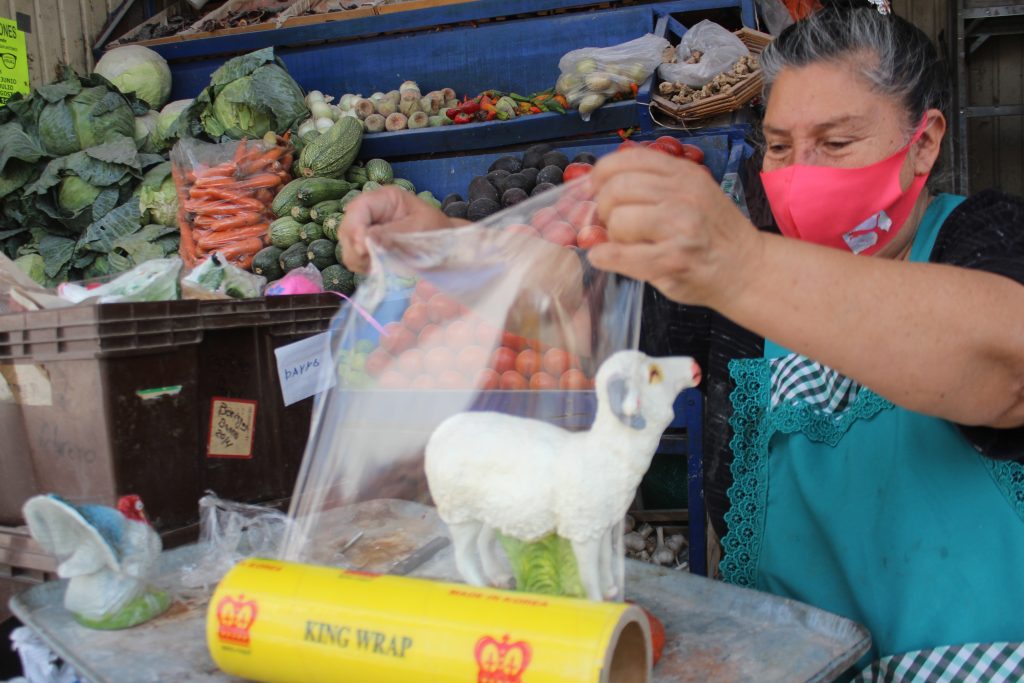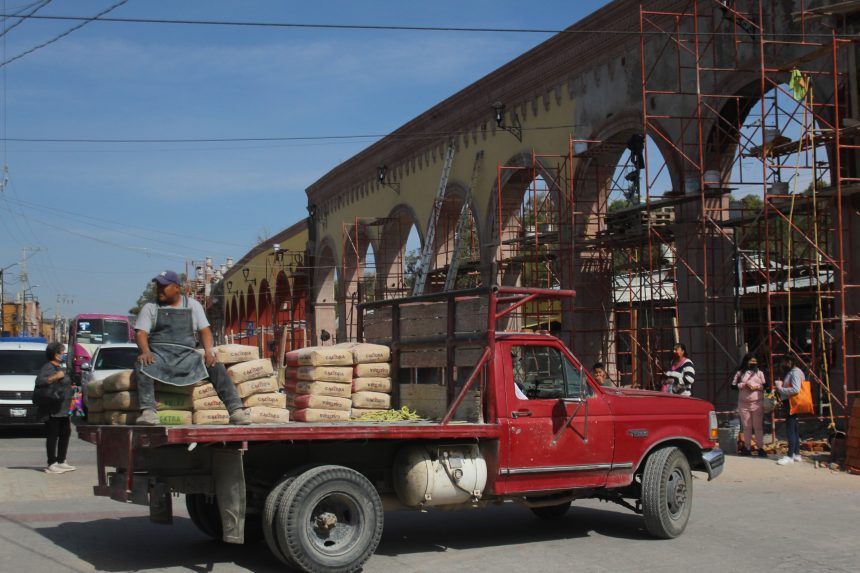More dust, fewer trees, less space and fewer sales are what remain of the 220-meter arcade on Avenida Guadalupe, a project that, far from helping merchants, has harmed them. They do not understand the sense of having spent 22 million pesos on the project.
Around Avenida Guadalupe is one of the most folkloric areas of the city. It is where people from the neighborhoods and communities in the west of the city converge. It is the largest local commercial area (after the Tuesday tianguis or open-air market), and includes Plaza San Miguel, Mercado de San Juan de Dios, and Plaza Guadalupe, plus the avenue’s shops. Items on offer range from a Santa Muerte, radios, computers, and cell phone repair to beauty products, cake stands, tamales, chopped fruit with chili and lime, etc.
The repaving of Avenida Guadalupe was inaugurated on Dec. 12, 2019, the Day of the Virgin of Guadalupe, patron saint of merchants. The archway was to have been completed in March 2020. That did not happen; the original plan for a quarry stone base and cornices was abandoned. This past August, the Department of Public Works and Infrastructure came up with the idea of replicating old mansions of the Historic Center. The 220 meters of archway, according to the Director of Public Works Antonio Soria, was considered monotonous, so on the instruction of Mayor Luis Alberto Villarreal, a new idea was conceived.
The revised concept was announced vaguely in August as “a tribute to San Miguel,” with the following statement: “Through its colonial architecture it will evoke the history of San Miguel to frame and continue the rescue of the Avenida Guadalupe zone. There are almost 240 linear meters of construction area divided in six sections, each with its architectural identity. It will take 120 calendar days to conclude the concept, in which 14 million pesos will be invested for the direct benefit of almost 15 thousand people who pass through there daily.”
It appears that details of the revised Public Works project were inspired by buildings of the Historic Center: materials, texture, scale, colors, and architectural elements. One of the replicas will be the facade of the Aldama Market, that was on the on one side of the parroquia.
However, the project was not completed on Dec. 12. On Dec. 9, Atención visited the area during the construction workers’ lunch break. We asked about when they would complete the Project, and they said, “Now it just needs to be cleaned up. All you see is rubble, it just needs to be removed. They told us that it has to be ready by Saturday” (which was the Day of the Virgin Guadalupe). But the project was not finished then, nor was it inaugurated.
Dust, mesh, and arches
Her face covered with a mask, but with smiling eyes, stall holder Doña Hortencia worked and chatted with us. “I became a widow thirty years ago and I had to take responsibility for my five children. How was I going to do that? Well, by selling. I don’t want to be pessimistic, but with the pandemic we have not done well. I think, though, that everything is going to improve. And now it is more beautiful. Hopefully more people will come. The construction did cause us a lot of inconvenience. Look, no one could pass through here. We had to open it there (she points to a corner of the mesh fencing), otherwise how would people reach us?” In front of her dusty pile of zucchini, avocados, and tomatoes, Doña Hortencia was wrapping sheep, shepherds, and other statuettes for nativity scenes in cellophane. She has two stands with her daughter, and she has faith that everything will improve this year or next.
In the dusty and subdivided stalls was a man selling Santa Muerte, Virgen de Guadalupe, and San Judas statuettes. “I am feeling sad waiting for someone to come and buy. They closed us down with the pandemic and since we returned, with all this mess they created people do not come. Let’s see if between tomorrow or the day after someone comes and takes the Virgin of Guadalupe since her saint’s day is near; or a Santa Muerte—it sells very well. The problem is that people do not want to come because of the inconvenience. Sales have been very poor. And what are those arches for, who are they good for? Not us. The government says that all merchants agree with the construction, but it is not true—ask the others. Those who say that they are doing well are the merchant leaders. They must have an exclusive benefit, but not us. They have also reduced our space,” the vendor commented.
Platforms such as Netflix, Amazon, and Claro have not overshadowed the sale of pirated movies and CDs; at least that’s what one of the sellers at the Guadalupe Market says. “The arrival of online platforms has not affected us. We were hit by the contingency, and then this construction work, from which we are not benefitting. The trees were removed and we did not agree, but those who complained were taken to jail. We did not agree with the construction of the arches; but we don’t want to protest because then the government looks for a way to close us down—they always know how—or they blackmail us. They have forced us to not protest,” said the merchant, who works a media stand with his wife. “I had to install a plastic curtain to keep out the dust. This construction project brings us no benefit. More beautiful for what or for whom?”
A resident and merchant on Avenida Guadalupe commented, “Look, we have more dust, less space, fewer trees, fewer sales.”
And so the comments go.

First yes, then no
The director of municipal Infrastructure and Public Works, Antonio Soria, first said that the merchants requested an improvement to the Guadalupe market—although several vendors told Atención that the entire idea was the government’s, which planned paving the avenue and the arcade that runs (on avenida Guadalupe) from San Rafael Street to Insurgentes. Initially it was said that the merchants had agreed to pay for 30 percent of the work. However, according to statements by unión leaders who preferred to remain anonymous, the unions (five in that area) were not even able to get 10 percent of their members to make the 7,000 peso contribution.
In the original project, the concrete columns in the arcade would be lined with quarry at their base, with the arch and cornice also including that material, and there would be a simple concrete roof.
With this Project, commerce was to have been regulated so that vendors would not occupy the pedestrian space to display their merchandise. Rather, the space was to be for customers, “like under the portals of the main square,” Soria commented. The original investment for the project was 7.5 million pesos. The municipal contribution was to have been 70 percent, with rest to be funded with contributions from merchants.
Soria said that as the project is extensive—with 220 meters in length, the architecture was monotonous; so at a meeting Mayor Luis Alberto Villarreal requested a modification “to enrich the details.” The Public Works collaborators conceived the idea of integrating architectural details of the Historic Center. “Nothing specific” the director clarified, “but there is the idea of the facade of a traditional house framed in stonework, a fountain, portals, and an interior patio, among other details.” The budget for the project increased to 22 million pesos, which, according to Soria, will be exclusively covered by the municipality. The director remarked that the merchants, according to the mayor, no longer had to make any contribution. “The archway part is attractive on its own; it doesn’t require plants. The additional element will be staged lighting. It is a visually attractive site,” concluded Soria.

